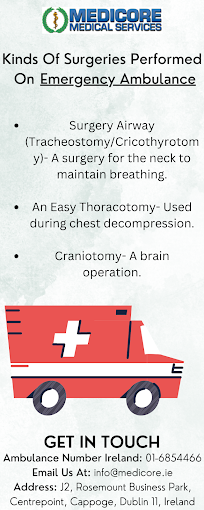The Benefits of Pre-hospital Care: Exploring the Impact of Emergency Ambulance Services
Pre-hospital care refers to the medical attention given to patients before they arrive at a hospital. Emergency ambulance services play a critical role in providing pre-hospital care to patients. The benefits of pre-hospital care are numerous and far-reaching.
In this blog, we will explore the impact of emergency ambulance services and the benefits of pre-hospital care.
Emergency ambulance services are categorized into four main types: Basic Life Support (BLS), Advanced Life Support (ALS), Critical Care Transport (CCT), and Special Operations. BLS ambulances are equipped to handle basic medical emergencies, such as administering oxygen and bandaging wounds. ALS ambulances are equipped to handle more complex medical emergencies, such as administering IV medication and advanced airway management. CCT ambulances are equipped to transport critically ill patients who require specialized medical equipment, such as ventilators. Special Operations ambulances are equipped to respond to specific types of emergencies, such as mass casualty incidents and hazardous material incidents.
Benefits of Pre-hospital Care The benefits of pre-hospital care are numerous and include:
Saves Lives: Pre-hospital care has been shown to save lives by providing early medical intervention before a patient reaches a hospital.
Reduces Morbidity and Mortality: Pre-hospital care has been shown to reduce the risk of long-term complications and disability.
Provides Timely Treatment: Pre-hospital care provides patients with immediate medical attention, which can be critical in cases where time is of the essence, such as during a heart attack or stroke.
Enhances Patient Outcomes: Pre-hospital care has been shown to improve patient outcomes by providing early diagnosis and treatment.
Reduces Hospitalization Time: Pre-hospital care has been shown to reduce hospitalization time by providing early intervention.
Reduces Healthcare Costs: Pre-hospital care can reduce healthcare costs by preventing the need for more expensive treatments and reducing hospitalization time.
EMS providers are the frontline workers who provide pre-hospital care to patients. EMS providers are trained and educated to provide medical care in emergency situations. They have specialized skills and knowledge to handle various medical emergencies and provide immediate medical attention to patients. EMS providers are responsible for providing high-quality care to patients and ensuring their safety during transportation to the hospital. Professional development is a crucial aspect of EMS providers' roles, as they must stay up-to-date on the latest medical treatments and technologies.
The Impact of Emergency Ambulance Services on Public Health Emergency ambulance services play a crucial role in public health by providing timely medical attention to patients. They help reduce morbidity and mortality rates by providing early intervention and treatment. Emergency ambulance services also improve access to emergency care, particularly in remote areas where hospitals may be far away. Furthermore, emergency ambulance services improve community health by providing education and training on emergency preparedness.
In conclusion, emergency ambulance services play a critical role in providing pre-hospital care to patients. The benefits of pre-hospital care are numerous, including saving lives, reducing morbidity and mortality, providing timely treatment, enhancing patient outcomes, reducing hospitalization time, and reducing healthcare costs. EMS providers are the frontline workers responsible for providing pre-hospital care to patients, and their professional development is critical for providing high-quality care. Emergency ambulance services have a significant impact on public health, improving access to emergency care and community health. As such, emergency ambulance services are an essential part of the healthcare system and should be prioritized for funding and resources.

.jpg)


Comments
Post a Comment